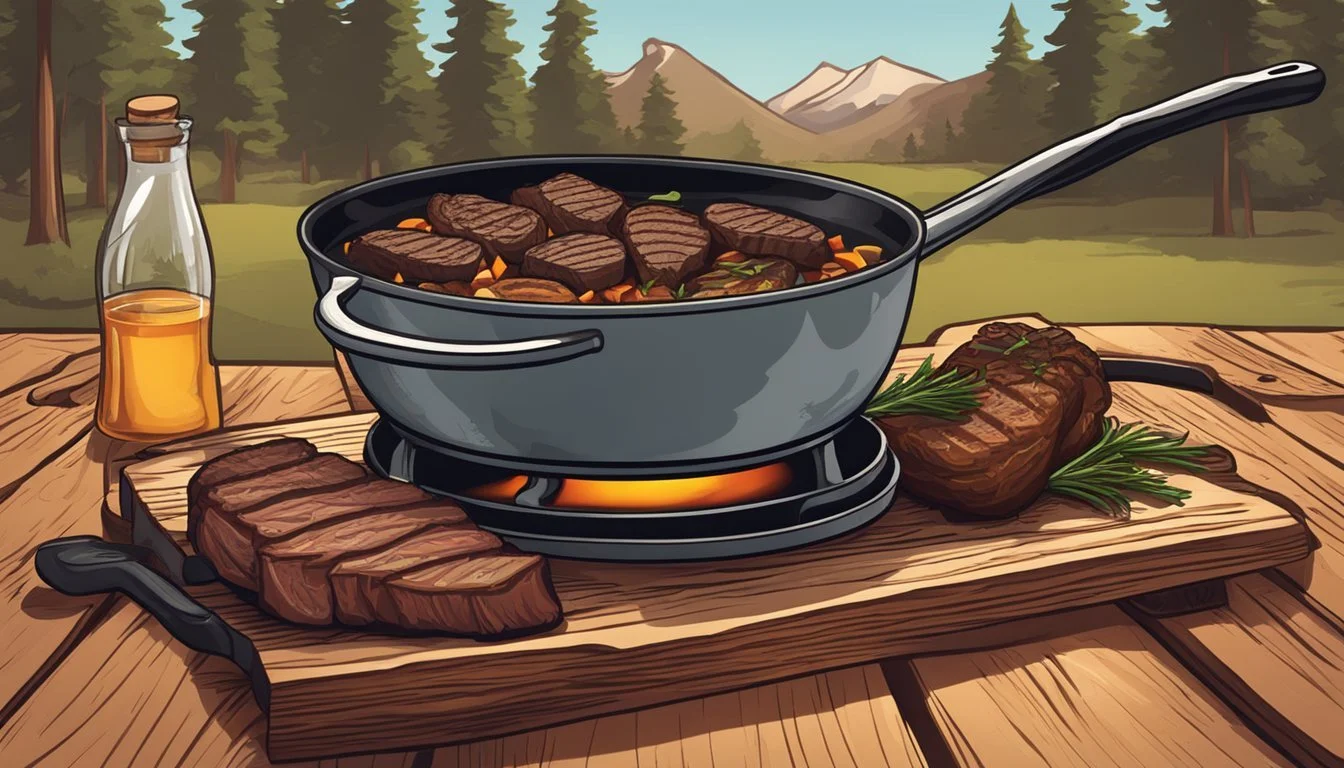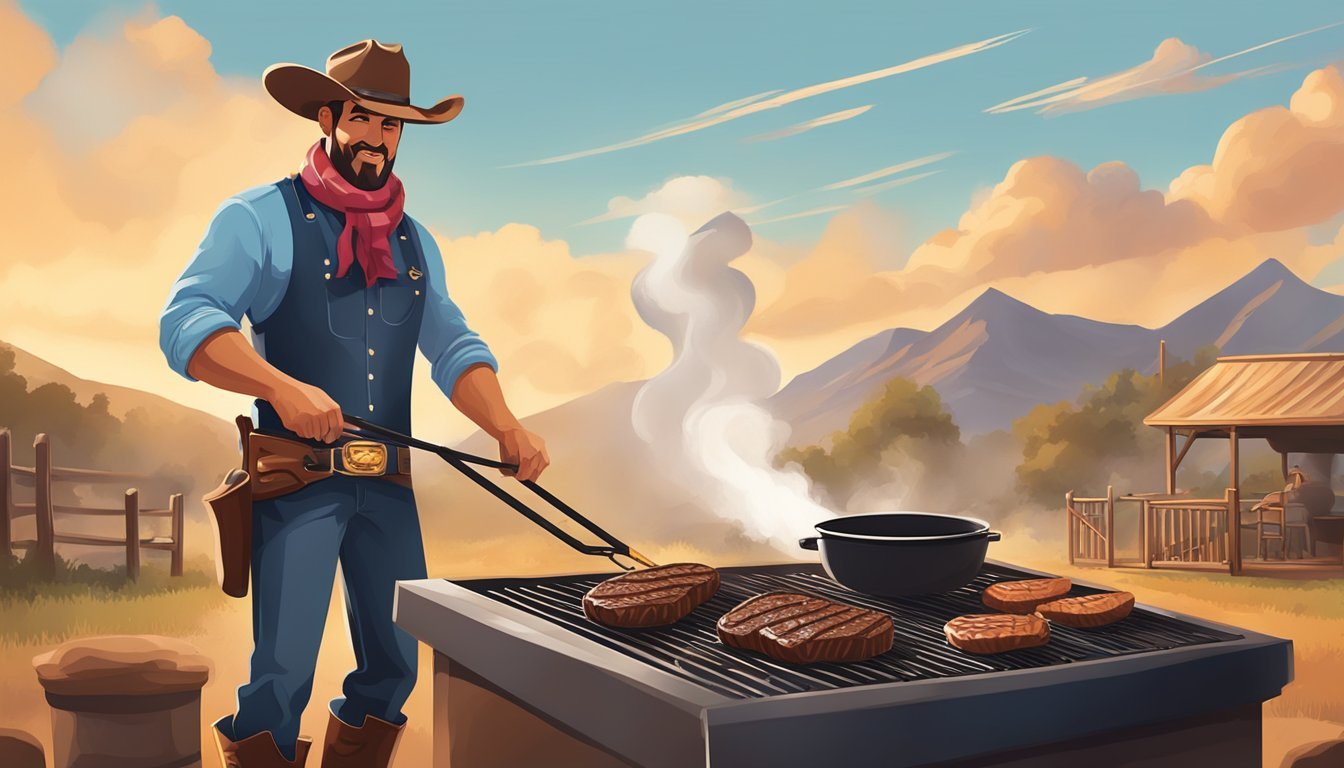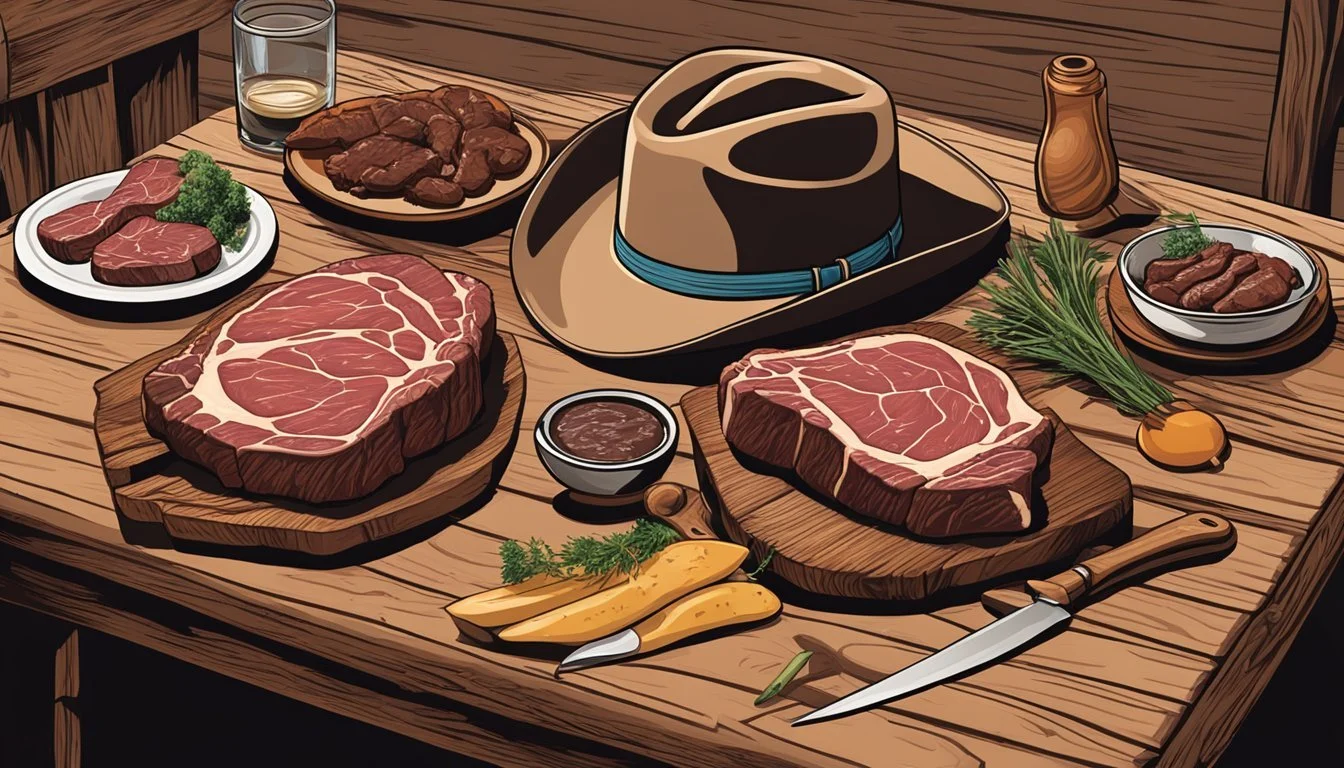The Best Cuts of Beef for Authentic Cowboy Cooking
A Guide to Robust Flavors
In the authentic cowboy kitchen, beef (What wine goes well with beef?) is a staple. The rugged panorama of the Wild West was the backdrop where cattle ranching thrived, bringing forth a culinary tradition that celebrated the cow in its entirety. Selecting the right cut of beef is pivotal for evoking the genuine flavors of cowboy cuisine. The art lies in understanding both the texture and the optimal cooking methods suited for each cut, ensuring every meal is as hearty as it is flavorful.
The most revered cuts for cowboy cooking come with a balance of marbling and muscle. Take, for example, the cowboy steak, often a bone-in ribeye, which is acclaimed for its rich taste and tenderness. This cut embodies the quintessence of cowboy fare—substantial and satisfying. Cooking it requires a method that respects its quality, often grilling over an open flame to achieve a caramelized crust while preserving a juicy interior.
Another beloved cut is brisket, a tougher piece that demands a slow cooking process to reach its potential. In the hands of a skilled cook, brisket transforms through hours of low and slow smoking into a tender and flavorful experience. It's this dedication to process and ingredient that defines cowboy cooking, a tradition that continues to be synonymous with the spirit of the American West and its enduring culinary heritage.
Understanding Beef Cuts
In authentic cowboy cooking, the selection and preparation of beef is pivotal to the culinary experience. This section dissects the classification of beef cuts, the role of marbling, and how to select the most suitable cut for a heartwarming meal.
Classifying Beef Cuts
Beef cuts are categorized based on the region of the cow from which they are sourced. Four primary sections contribute to the variety of cuts available: the rib, loin, shoulder (also known as chuck), and round. The rib section yields richly flavored cuts like ribeye steaks (What wine goes well with ribeye steak?), ideal for grilling due to their balance of meat and fat. The loin produces highly tender selections, including the T-bone and filet mignon, which are prime candidates for high-heat cooking methods such as grilling and searing. Chuck harbors more connective tissue, leading to tougher cuts that are excellently suited for braising.
The Importance of Marbling
Marbling refers to the fine, web-like intramuscular fat found within high-quality beef cuts, primarily seen in prime beef. It is a crucial factor in determining the tenderness, juiciness, and flavor of the meat. Cuts with a higher degree of marbling are typically more succulent and flavorful, as the fat melts during cooking, enhancing the overall taste and texture.
Selecting the Right Beef Cut
When selecting beef cuts for cowboy cooking, consider the cooking method and desired tenderness. Tougher cuts like chuck and brisket, rich in connective tissue, are optimal for low-and-slow braising, which allows the tissues to soften and yield a fork-tender texture. For quick cooking methods, choose tender cuts such as loin steaks, which require minimal cooking time to maintain their succulence. Consult a butcher for specific cuts like hanger steak, a flavorful option that remains tender with proper preparation.
Perfecting Cowboy Steak Preparation
Mastering the preparation of cowboy steak involves understanding how to blend seasonings for a robust flavor and utilizing precise grilling techniques to achieve the ideal texture and doneness.
Authentic Seasoning Mixes
Crafting the perfect cowboy steak starts with the dry rub. An authentic cowboy rub combines coarse textures and bold flavors. Here's a tried-and-true blend:
2 tbsp kosher salt
1 tbsp crushed black pepper
1 tbsp brown sugar
1 tsp chili powder
1 tsp cumin
Apply the mixture generously to the steak, ensuring an even coat. The sugar will help to create a caramelized crust, while the kosher salt and spices penetrate the meat to enhance its natural flavors.
The Art of Grilling and Smoking
Grilling and smoking are quintessential to achieving the signature cowboy steak's slightly chewy yet tender consistency. A cowboy steak, often compared to a tomahawk steak due to its size and bone, is best cooked using a two-zone heat method on the grill. Here's a straightforward guide:
Initial Sear: Over high heat, sear each side for 3-5 minutes to form a golden crust.
Move to Lower Heat: Transfer the steak to a lower heat setting and cook for 11-15 minutes on each side. Use a meat thermometer to target a 130°F internal temperature for a perfect medium-rare finish.
Rest Before Serving: Allow the steak to rest for 5-10 minutes after grilling. This step lets the juices redistribute, maintaining the steak's moisture.
Achieving perfection with cowboy steak is about the harmony between a robust seasoning blend and meticulous grilling. Following the guidelines above, one can create a steak that pays homage to the authentic cowboy cooking tradition.
Iconic Cowboy-Specific Cuts and Dishes
The traditional cowboy diet was hearty and focused heavily on beef, utilizing specific cuts that were both flavorful and could be cooked easily over campfires or cast iron stoves. Below, one can explore the cuts that defined cowboy cuisine and discover how cowboy cooking transcends beef to include a broader array of rustic dishes.
Specialty Cuts for the Cowboy Palette
Cowboy Steak: This is essentially a thick, bone-in ribeye often weighing upwards of two pounds. It is known for its marbling and tends to be seasoned with a simple yet robust blend of spices before grilling.
Sirloin: Valued for its balance between flavor and leanness, sirloin makes a fulfilling choice for steaks and kabobs with a hearty, satisfying chew.
Tri-tip: A cut from the bottom sirloin, this is often seasoned generously and roasted or grilled to showcase its full flavor.
Flank Steak: Though tougher, this cut is traditionally marinated and then cooked quickly over high heat, resulting in a tasty main course when sliced against the grain.
Skirt Steak: Similar to flank, skirt steak is best when marinated and seared, often utilized in fajitas, a cowboy-inspired dish.
Cowboy cooking staples such as beans and potatoes often accompany these cuts, usually cooked in sauces with tomatoes or pinto beans for depth of flavor. These sides not only provide sustenance but also complement the bold tastes of the meats.
Cowboy Cooking Beyond Beef
Cowboy cuisine extends beyond beef, integrating a variety of ingredients:
Eggs: Frequently used in breakfast dishes, eggs are a staple in cowboy cooking, often featured in hashes or alongside meats.
Cowboy Cookies: A sweet treat, these cookies are a rich mix of oats, chocolate, and nuts, offering a durable snack for long days on the trail.
Filet Mignon, Porterhouse, and Hanger Steak: While not as commonly associated with cowboy cooking due to their tenderness and, in times past, price, these cuts have found their way into modern cowboy kitchens, offering a more luxurious take on the classic cowboy fare.
While this cuisine is simple and unpretentious, it is also known for its robust flavors and hearty portions, ensuring that the legacy of the cowboy's kitchen lives on.
Grilling Techniques and Tips
The secrets to authentic cowboy cooking on the grill lie in mastering heat management and understanding the resting period of meat.
Achieving the Perfect Grill Marks
Grill marks are not just about aesthetics; they contribute to the characteristic smokiness of grilled meat. To achieve perfect grill marks, one must preheat the grill to a high temperature before placing the meat on it. Here are specific steps to ensure those hallmark crosshatch patterns:
Preheat the grill to high; this could be around 400-450°F (200-230°C).
Place the steak on the grill at a 45-degree angle to the bars of the grill grate.
After a few minutes, rotate the steak 90 degrees without flipping it to create the crosshatch pattern.
Flip the steak only once, repeating the process to sear the other side.
Resting Meat for Optimal Flavor
Resting meat after grilling is a crucial step to lock in flavor and juices. During this time, the heat continues to distribute throughout the meat, leading to a more tender and flavorful result. Here's how to rest meat properly:
Remove the steak from the grill once it reaches the desired level of doneness.
Place it on a warm plate or cutting board.
Loosely cover the steak with foil to keep it warm.
Rest the steak for about half the time it took to cook it. This allows juices to reabsorb into the meat fibers.
Cut against the grain to serve for the tenderest eating experience.
Sourcing and Sustainability
In the realm of authentic cowboy cooking, the choice of beef cuts—from prime rib to a simple steak—reflects not just taste but a commitment to sustainable and ethical practices.
Ethical Meat Sourcing Practices
Grass-fed beef is widely regarded as a more sustainable option compared to its grain-fed counterparts. Supporting local Texas ranches that adhere to organic standards ensures that the cattle are not only raised in open pastures but also treated without synthetic hormones or antibiotics. Consumers who prioritize sustainability should seek out organic farms and those that practice rotational grazing to minimize environmental impacts and assure the ethical treatment of cows.
Local Farms: Promotes shorter supply chains, reducing carbon footprint.
Certified Organic: Ensures no synthetic fertilizers or GMOs are used.
Impact of Beef Consumption on Health
The consumption of beef, particularly in traditional cowboy cuisines like prime rib, can provide key nutrients essential for health. However, the sourcing of beef has health implications. Grass-fed beef tends to have a higher concentration of omega-3 fatty acids and antioxidants, which are beneficial for health, in contrast to grain-fed options. At the same time, moderation in beef intake can be part of a balanced diet, and incorporation of a variety of food groups is essential for overall wellness.
Grass-Fed Benefits: Higher in beneficial nutrients like omega-3s.
Balanced Diet: Incorporating beef with vegetables, grains, and other proteins can lead to better health outcomes.
Cowboy-Specific Seasonings and Condiments
When preparing dishes steeped in cowboy tradition, the choice of seasonings and condiments is as paramount as selecting the right cut of beef. The robust flavors one would expect in cowboy cooking come from a harmonious blend of common ingredients, each serving a unique purpose to enhance the meat's natural flavors.
Salt forms the foundation of seasoning and is indispensable for bringing out the beef's inherent savory notes. It's a simple but essential ingredient in cowboy cuisine. Black pepper, often paired with salt, adds a punch of heat and complexity. Traditionally, cowboys would utilize whatever was at hand, but these basic elements were staples.
Moving on to sweeter notes, sugar sometimes finds its place in cowboy recipes in small quantities, contributing to a well-rounded flavor profile, particularly in barbecue sauces or to create a caramelized crust on grilled meats. (What wine goes well with grilled meats?)
Garlic is a non-negotiable for its robust and earthy aroma, invariably present in cowboy kitchens. It's often used fresh, minced, or in powdered form, delivering a pungent punch that complements beef wonderfully.
Cowboys didn't shy away from bold flavors; chili and mustard provided heat and tang. Chili, whether as a powder, in a sauce, or as fresh pepper, brings a smoky heat, while mustard adds a piquant taste, perfect for slathering on meats before cooking.
For a burst of umami and complexity, Worcestershire sauce is the cowboy's secret weapon. Its rich, tangy depth flavors stews and marinades alike.
Lastly, olive oil, while not traditional in the Old West, is now commonly used for its health benefits and ability to cook at high temperatures. It serves as an excellent base for marinades and for sautéing vegetables to accompany the beef.
In summary, cowboy-specific seasonings and condiments are rooted in enhancing the natural flavors of beef with a balance of salt, sweetness, heat, and umami, all tailored to create robust and hearty dishes that satisfy the appetite honed by the open range.
Cooking Methods of the Cowboy Cuisine
Authentic cowboy cuisine is rooted in practical cooking methods that could be employed on the open range. These methods prioritized simplicity and utility, given the limited resources available to cowboys during long cattle drives.
Grilling is perhaps the most iconic cooking method associated with cowboy cuisine. A grill, often an open flame, is the central apparatus for cooking meats like the cherished ribeye. The ribeye's rich marbling provides an excellent flavor and juiciness, ideal for grilling over high heat.
Direct Heat Grilling: Ribeye and back ribs are typically cooked over direct heat to achieve a charred exterior while preserving a tender interior.
Cowboys utilized cast iron pans and Dutch ovens heavily. These tools are durable and versatile, suitable for searing and slow-cooking various cuts.
Pan Searing: Flat iron, a less marbled but flavorful cut, benefits from high-heat searing in a cast iron pan to lock in juices before further cooking.
Another method is braising, especially for tougher cuts like back ribs. Braising involves slow-cooking the meat in a flavored liquid, transforming it into a tender, pull-apart texture.
Braising: Long cook times over low heat in minimal liquid amplify the natural flavors of the beef.
Ingredients used are simple yet robust, often consisting of salt, pepper, and native herbs, reflecting the cowboys' preference for a natural meat taste.
Cooking Method Ideal Beef Cut Note Grilling Ribeye, Back Ribs Quick, high-heat method, suits marbled cuts. Pan Searing Flat Iron Best over high heat, achieves a crusty exterior. Braising Back Ribs Slow-cooked, submerged partly in liquid for tenderness.
Cowboy cooking methods are emblematic of a rugged, straightforward approach to food, which highlights the quality of the ingredients without unnecessary complexity.
Pairing Sides with Cowboy Beef Cuts
When considering sides to serve alongside cowboy beef cuts, the aim is to complement the robust flavors and satisfy the hearty appetite often associated with cowboy cooking.
Classic Vegetables:
Corn: Grilled or roasted ears of corn provide a sweet contrast to the savory meats.
Beans: Simmered pinto beans or baked beans offer a creamy texture and are a staple in cowboy cuisine.
Starchy Accompaniments:
Potatoes: Ideal for soaking up the flavorful juices from the beef cuts, potatoes can be baked, mashed, or roasted with herbs and a touch of cheese for added richness.
Cheese:
Incorporating cheese into sides such as a cheesy potato casserole or sprinkling it over roasted vegetables can enhance the overall flavor profile of the plate.
Suggested Pairing Combinations:
Main Cowboy Beef Cut Suggested Side Grilled Cowboy Steak Herb Roasted Potatoes, Grilled Corn Smoked Brisket Pinto Beans, Cheesy Casserole Braised Short Ribs Mashed Potatoes, Roasted Vegetable Medley
Selecting the right sides to accompany the mains is essential for creating a balanced and satisfying plate. Robust and rich flavors from the beef pair well with sides that can stand up to the heartiness without overpowering the main attraction.
Finishing Touches and Presentation
Once the beef is expertly cooked to its ideal tenderness, a chef's attention must shift to the art of presentation. Resting the meat is paramount; it allows the juices to redistribute, ensuring that each bite is succulent. Ideally, beef should rest for about 5 to 10 minutes before slicing.
Sauce is a crucial element. Whether it’s a simple reduction or a complex concoction, the sauce should complement the beef's robust flavors. A chef should be judicious in its application, accentuating rather than overpowering the meat.
Ingredients for garnishing must be chosen with care. Fresh herbs can add a pop of color and flavor, while olive oil can provide a glossy, appetizing sheen. Lightly sautéed bell peppers not only bring vibrant color to the plate but also contribute a subtle sweetness that pairs well with a rich cut of beef.
Careful attention should be paid to how the beef is sliced. Thin, even slices presented neatly on the plate allow for an appealing visual and textural experience. The angle and direction of the cut can also impact the texture, with across-the-grain slices resulting in a more tender chew.
Here's a simple outline for arranging the final presentation:
Let the beef rest post-cooking to retain juices
Apply sauce sparingly and with purpose
Garnish with ingredients that enhance both look and taste
Fresh herbs
A drizzle of olive oil
Sautéed bell peppers
Slice the beef against the grain for optimal tenderness
Each of these elements is critical for presenting a dish that not only tastes delicious but is visually stunning and true to the authentic cowboy cooking experience.






